External links
| | This article about a music-related documentary film is a stub. You can help Wikipedia by expanding it. |
Marian Anderson: The Lincoln Memorial Concert is a 1939 documentary film that documents a concert performance by African American opera singer Marian Anderson after the Daughters of the American Revolution (DAR) had her barred from singing in Washington D.C.'s Constitution Hall because she was Black. Officials of the District of Columbia also barred her from performing in the auditorium of a white public high school. First Lady Eleanor Roosevelt helped hold the concert at Lincoln Memorial, on federal property. [1] The performance on Easter Sunday, April 9, 1939, was attended by 75,000. [2] In 2001, this documentary film was selected for preservation in the National Film Registry by the Library of Congress.

The Lincoln Memorial is a U.S. national memorial that honors the 16th president of the United States, Abraham Lincoln. An example of neoclassicism, it is in the form of a classical temple and is located at the western end of the National Mall in Washington, D.C. Henry Bacon is the memorial's architect and Daniel Chester French designed the large interior statue of a seated Abraham Lincoln (1920), which was carved in marble by the Piccirilli brothers. Jules Guerin painted the interior murals, and the epitaph above the statue was written by Royal Cortissoz. Dedicated on May 30, 1922, it is one of several memorials built to honor an American president. It has been a major tourist attraction since its opening, and over the years, has occasionally been used as a symbolic center focused on race relations and civil rights.

Marian Anderson was an American contralto. She performed a wide range of music, from opera to spirituals. Anderson performed with renowned orchestras in major concert and recital venues throughout the United States and Europe between 1925 and 1965.

"My Country, 'Tis of Thee", also known as simply "America", is an American patriotic song, the lyrics of which were written by Samuel Francis Smith. The song served as one of the de facto national anthems of the United States before the adoption of "The Star-Spangled Banner" as the official U.S. national anthem in 1931. The melody used is adopted from the national anthem of the United Kingdom, "God Save the King".

Harold LeClair Ickes was an American administrator, politician and lawyer. He served as United States Secretary of the Interior for nearly 13 years from 1933 to 1946, the longest tenure of anyone to hold the office, and the second longest-serving Cabinet member in U.S. history after James Wilson. Ickes and Labor Secretary Frances Perkins were the only original members of the Roosevelt cabinet who remained in office for his entire presidency.

Sol Hurok was a 20th-century American impresario.

Camilla Ella Williams was an American operatic soprano who performed nationally and internationally. After studying with renowned teachers in New York City, she was the first African American to receive a regular contract with a major American opera company, the New York City Opera. She had earlier won honors in vocal competitions and the Marian Anderson Fellowship in 1943–44.
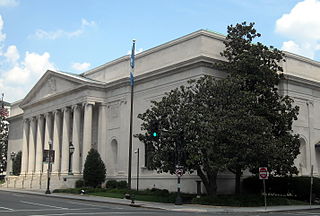
DAR Constitution Hall is a concert hall located at 1776 D Street NW, near the White House in Washington, D.C. It was built in 1929 by the Daughters of the American Revolution to house its annual convention when membership delegations outgrew Memorial Continental Hall. Later, the two buildings were connected by a third structure housing the DAR Museum, administrative offices, and genealogical library. DAR Constitution Hall is still owned and operated by the National Society of Daughters of the American Revolution. It was designated a National Historic Landmark in 1985. It has been a major cultural center of the city since its construction, and houses its largest auditorium.

First Lady Suite is a chamber musical by Michael John LaChiusa. The musical contains four separate segments about four of the First Ladies of the United States of America and the people surrounding them. They are: Eleanor Roosevelt, Mamie Eisenhower, Bess Truman, and Jacqueline Bouvier Kennedy. It premiered Off-Broadway in 1993.

The Abraham Lincoln Bicentennial Commission (ALBC) was the congressionally created, 14-member federal commission focused on planning and commemorating the 200th birthday of the United States' 16th president on February 12, 2009. The commission served for ten years, from 2000 to 2010. Its official successor organization, announced in 2011 with an expanded board and broadened mission, is the Abraham Lincoln Bicentennial Foundation.
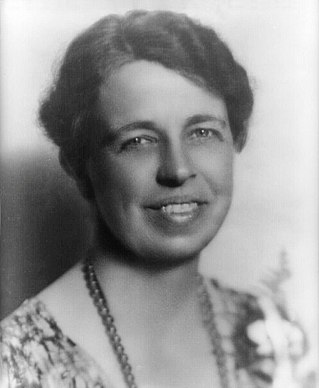
Anna Eleanor Roosevelt was an American political figure, diplomat, and activist. She was the first lady of the United States from 1933 to 1945, during her husband President Franklin D. Roosevelt's four terms in office, making her the longest-serving first lady of the United States. Through her travels, public engagement, and advocacy, she largely redefined the role of First Lady. Roosevelt then served as a United States Delegate to the United Nations General Assembly from 1945 to 1952, and in 1948 she was given a standing ovation by the assembly upon their adoption of the Universal Declaration of Human Rights. President Harry S. Truman later called her the "First Lady of the World" in tribute to her human rights achievements.
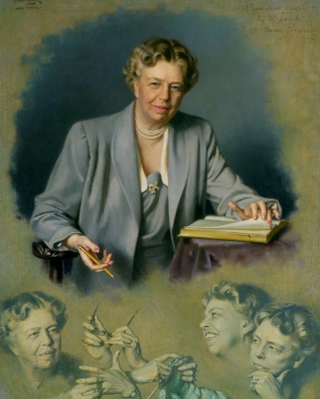
My Day was a newspaper column written by First Lady of the United States Eleanor Roosevelt (ER) six days a week from December 31, 1935, to September 26, 1962. In her column, Roosevelt discussed issues including civil rights, women's rights, and various current events. This column allowed ER to spread her ideas, thoughts, and perspectives on contemporary events to the American public through local newspapers. Through My Day, Roosevelt became the first First Lady to write a daily newspaper column. Roosevelt also wrote for Ladies Home Journal, McCall's, and published various articles in Vogue and other women's magazines.

Eleanor and Franklin: The White House Years is a 1977 American made-for-television film and a sequel to Eleanor and Franklin (1976). Originally airing on March 13, 1977, it was part of a two-part biographical film directed by Daniel Petrie based on Joseph P. Lash's Pulitzer prize-winning biography, Eleanor and Franklin, chronicling the lives of the 32nd U.S. President and the first lady. Joseph Lash was a secretary and confidant of Eleanor and wrote other books on the couple.

Emily May Gibson Braerton was an American activist who was an early advocate of historic preservation in the western United States. She was the Vice President General for the National Society of the Daughters of the American Revolution (DAR) from 1950–1953 and remained an Honorary Vice President General until her death in Santa Ana, California in 1966. She was a member of the DAR's Peace Pipe Chapter and served as Colorado State Regent from 1950–1953.
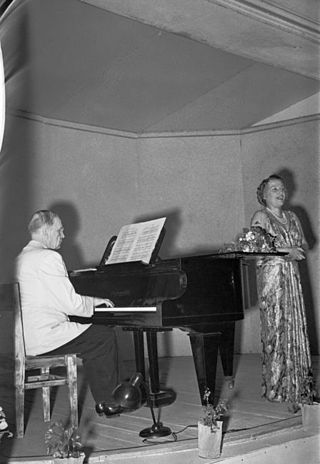
Kosti Vehanen was a Finnish pianist and composer. As a pianist he performed in more than 3,000 concerts on four continents. While he did perform as a concert soloist with major symphony orchestras and performed in recitals, he is best remembered for his prolific work as an accompanist with some of the most important singers of the first half of the 20th century. As a composer, he produced piano pieces, arrangements of folk songs, solo songs, two ballets, and a violin and cello fantasy. In addition, Vehanen also penned several memoirs, including 1941 book chronicling his decade long experience serving as Marian Anderson's accompanist.
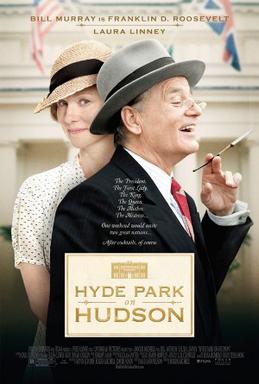
Hyde Park on Hudson is a 2012 historical comedy-drama film directed by Roger Michell. The film stars Bill Murray as Franklin D. Roosevelt, Olivia Colman as Queen Elizabeth and Laura Linney as Margaret "Daisy" Suckley, a cousin and childhood friend of the President. It was based on Suckley's private journals and diaries, discovered after her death and fictionally dramatizes her close relationship with Roosevelt and the 1939 visit of King George VI and Queen Elizabeth to Roosevelt's country estate.

The Marian Anderson House is a historic home located in the Southwest Center City neighborhood of Philadelphia, Pennsylvania. Built circa 1870 in the same neighborhood where opera singer and civil rights advocate Marian Anderson was born 27 years later, this two-story, brick rowhouse dwelling was designed in the Italianate style. Purchased by Anderson in 1924, the same year she became the first African-American concert artist to record spirituals for a major American recording company, she continued to reside here until 1943. The house is currently home to the Marian Anderson Museum and Historical Society.

Ruby Hurley was an American civil rights activist. She was a leader in the Civil Rights Movement and administrator for the NAACP, and was known as the "queen of civil rights".
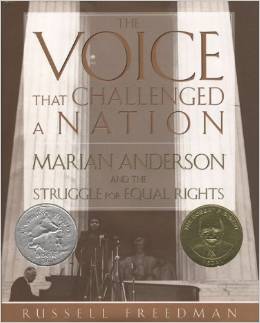
The Voice That Challenged a Nation: Marian Anderson and the Struggle for Equal Rights is a 2004 children's nonfiction book by Russell Freedman. It received both a Sibert Medal and a Newbery Honor Book award in 2005. The book tells the story of Marian Anderson, an African-American contralto, who during her journey to establishing a singing career, inadvertently became an activist for civil and political rights.
Frank Washington Ballou was superintendent of Washington D.C. public schools from 1920 to 1943. Frank W. Ballou High School is named in his honor. He was the first president of the National Association of Directors of Educational Research, the organization that would eventually become the modern American Educational Research Association.

Sarah Emily Corbin Robert served as the 17th President General of the Daughters of the American Revolution and was a noted authority on parliamentary procedure.